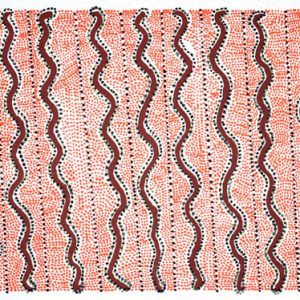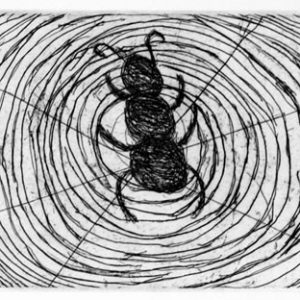Description
The artist has depicted part of the story for the Wati Kutjarra Tjukurrpa or Two Men Dreaming, in the country south of Balgo. The central shapes (the larger, single shape is the older brother, the smaller inside shape, is the younger one) are the two brothers sleeping by their fire in country called Yayarr. The Wati Kutjarra Tjukurrpa is an immensely significant story for a number of Indigenous Australian groups. In their ancestral journeyings, these Two Goanna Men traversed a very large expanse of land including that of the Warlpiri, Pintupi, Kukatja, Walmajarri and Ngardi peoples, as well as even further afield, through the Pitjantjatjara lands. The story arose as a result of the lawlessness of a lustful old man of the Tjungurrayi skin group who lived with many women with whom he had sexual relations, regardless of whether or not they were in the ‘right’ kinship affiliation with him to be suitable marriage partners. Whenever boy children were born to any of his wives, Tjungarrayi would order the babies to be killed. By ordering the deaths of the boys, Tjungarrayi was clearly getting rid of potential sexual competitors. Girl babies he did however allow to survive but, in some versions of this Dreaming narrative, even this has some rather nasty connotations given the man’s sexual proclivities. Eventually two baby boys were born at around the same time, to two of Tjungarrayi’s many wives. The mothers, who were finding that having to kill and bury the tiny bodies of all of their boy babies was unbearably upsetting, defied their husband, taking the two babies far away from where the group was camped, to a place obscured by a large sandhill, where first they breast-fed their infants and then later, clandestinely smuggled food for the children to eat. The two boys thrived, growing to healthy manhood, all the time plotting to take their revenge on their father. After some time the two, who by now were young men, put their plan into action. They visited their father’s brother, another Tjungarrayi, who lived some distance away and managed to convince him that their father intended to prey upon and steal that particular brother’s wives. The brother, outraged, crept up on the boy’s father and, at close range, threw a boomerang at him with great force, almost fatally wounding the man, who did however manage to retaliate, eventually killing his brother. This sequence of events, or this “original sin”, if you like, acts as a catalyst for a further whole chain of significant Dreaming events. The narrative also acts as a moral template, in which the importance of observing marriage laws is stressed. In oral versions, for example that of Peggy Rockman Napaljarri, the depiction of the transgressor’s punishment for breaching the Law figures prominently. As a result, the two sons (or Two Goanna Men, now the Dreaming Ancestors for so many Indigenous peoples), took off, travelling over great tracts of desert country, going in and out of the ground at various places, creating natural phenomena, and drinking from rockholes and soakages and leaving traces of their presence in the landforms. As Lee Cataldi has written, the sons ‘become the culture heroes of a whole cycle of myths concerning the Two Men. A major sequence of the Two Men centred around a place called Yaka Yaka which includes typical culture hero activities as teaching people to use fire and and cook their food’. Apart from the fact that there is not one baby boy, but two, later to become the ‘Two Men’ of this Dreaming, there are a number of uncanny parallels in this Dreaming to the story of Moses in the Christian Bible, and some echoes of the Oedipal drama as well.




